Sparkle 8800 GT Passive: The Fastest Silent GPU in the World
by Anand Lal Shimpi on November 29, 2007 12:00 AM EST- Posted in
- GPUs
The Sparkle 8800 GT Passive
This article is called a preview because the 8800 GT Passive just isn't out yet, but Sparkle assures us that it'll be available soon from TigerDirect at $319.
As we've already mentioned, the 8800 GT Passive is bone stock running at a 600MHz core clock, 1.5GHz shader clock and 1.8GHz memory data rate. In other words, this passively cooled best will perform identically to the 8800 GT we reviewed at the end of October. Impressive, if it works.
The front of the card is amazingly simple, there's a black plate where we'd normally see a massive heatsink and a small Sparkle logo, well, sparkles, in the lower right. Sparkle keeps the tough job of cooling away from the front, instead all we've got here is a plate that attaches three heatpipes to the G92 GPU.
The heatsink wraps around the back of the card, keeping it closer to the CPU in your system. The idea is to keep the heatsink in the path of a large case or PSU fan to help keep it cool since the card has no fan of its own. The heatpipes do a great job of moving heat away from the GPU but heatsinks work best if they have some air carrying heat away from the fins.
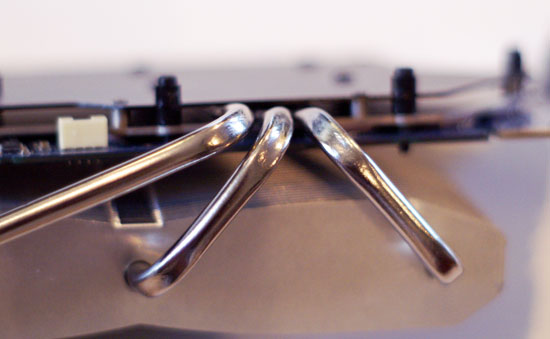
The heatsink design itself is pretty simple; there are a lot of fins made out of a very lightweight aluminum to keep the card's weight down. Despite the larger heatsink the card doesn't seem to weigh any more than a stock 8800 GT. On the flip side you've got to be extra careful with the 8800 GT Passive because these fins are easily damaged, so if you were planning on a sporty game of discus with your 8800 GT don't make it this one.

The rest of the card's attributes are standard 8800 GT fare. There's a 6-pin PCIe power connector on one end, two dual-link DVI ports at the other. S-Video out if you want blurry output to a TV, and a single SLI connector if you want to really push the limits and try two passively cooled 8800 GTs in a single system.
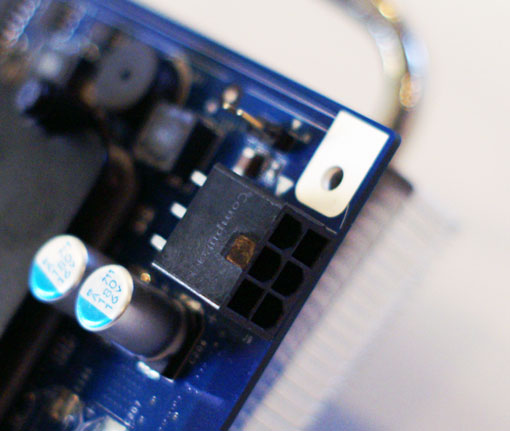
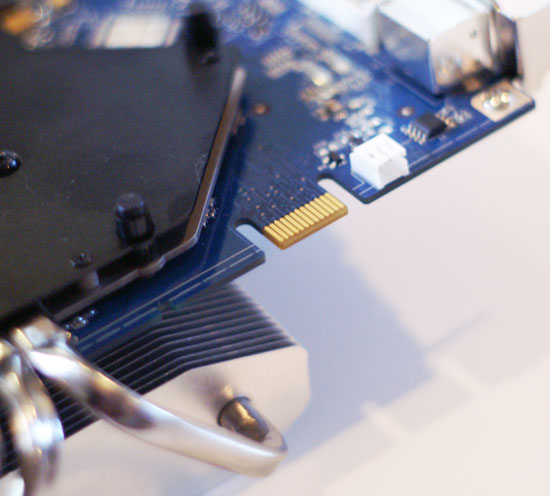


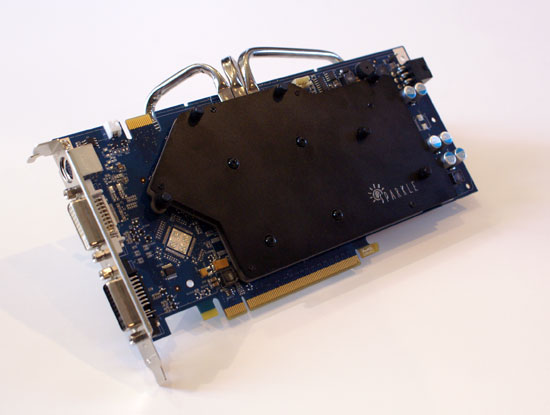
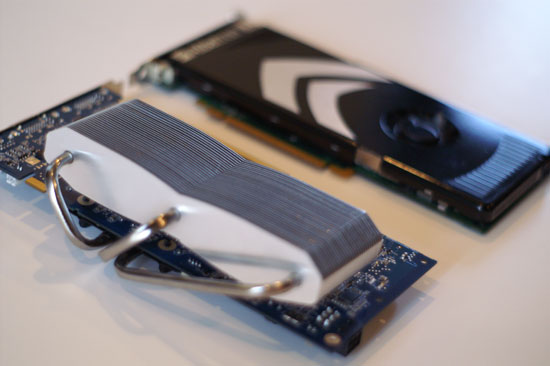
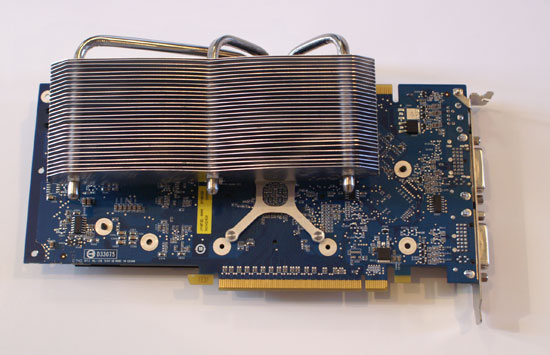








55 Comments
View All Comments
natrap - Saturday, December 1, 2007 - link
I agree with Cerb. The fact that it reached 111C and did not fail is a good sign. And that was recorded with the case fans off in a poorly ventilated case. I'm gonna get this for an Antec Solo which has a single 120mm case fan at the rear over the CPU. I'd expect a temp a little lower. As for such high temps affecting the life of the card, well it does come with a 12 month warranty. If it hasn't failed in that time running close to 24/7 then the chance of it failing soon after isn't going to be a great deal higher.natrap - Saturday, December 1, 2007 - link
I agree with Cerb. The fact that it reached 111C and did not fail is a good sign. And that was recorded with the case fans off in a poorly ventilated case. I'm gonna get this for an Antec Solo which has a single 120mm case fan at the rear over the CPU. I'd expect a temp a little lower. As for such high temps affecting the life of the card, well it does come with a 12 month warranty. If it hasn't failed in that time running close to 24/7 then the chance of it failing soon after isn't going to be a great deal higher.Allen Iverson - Saturday, December 1, 2007 - link
Great article anand, LOVE the Sparkle thumbnail :Dgochichi - Friday, November 30, 2007 - link
A lack of HDMI for this type of card is simply unacceptable.I wish the heat pipes wrapped further down, and in general, fan-less cards such as these (the ones that perform) should come with the option of adding standard two 80mm or one 120mm fans. The heat sink needs to be more impressive.
I have (though I don't use it anymore) a fan-less X800, and while it was marginally fine for a while to use it fan-less, I used to lay a quiet 80mm on top of it... I wish I could have easily secured the fan.
You see, fan less cards are meant for the few, the people that want more options. The price could easily be $350.00 if the card was right, and it be THE card to own for the enthusiast. You could down clock the card and slap it into a poorly ventilated case, or you could slap two 80mm fans on it and overclock it more than any other.
That's my two cents. To me, this is no good... if you care about quietness, it would be better to buy a regular card that self-cools... b/c leaving it up to the case means multiplying the noise.
harpoza - Friday, November 30, 2007 - link
Next day shipping almost always costs $30-$50. I'm not sure why this is so notable?Bozo Galora - Friday, November 30, 2007 - link
Or, you could have run the card at 54 degrees under load by using the new Thermalright HR-03GT GPU HS with 92mm Fan.http://forums.vr-zone.com/showthread.php?t=208305">http://forums.vr-zone.com/showthread.php?t=208305
You still could even amend this article with same, or even do a new one in cases cooling. Then you would have both ends of the spectrum.
And, supposedly, according to one report on the web, the 8800GT was not a paper launch, but some components needed for the board were in short supply. "Nvidia declined to say which ones".
kilroy0097 - Friday, November 30, 2007 - link
My point being, after looking at this review and testing of the Sparkle version of the 8800GT, it seems to me to be an added cost for less than adequate benefit. Perhaps you won't be using the card to play games like Crysis at full break to see how hot it can get and for those people this will probably be just fine. However for those that want silence and power wouldn't it be better to get a stock 8800GT, the cheapest you can find and then put on a Thermalright HR-03 Passive VGA cooler that is made for Nvidia 8800 cards. It achieves the same thing as Sparkle's design except it's made to better dissipate the heat. Granted it costs around $50 but it's also larger and more efficient. I think personally it's a safer and better alternative than the Sparkle design. Though kudos to Sparkle for at least attempting.scottb75 - Friday, November 30, 2007 - link
What kind of computer case (if any) was used for this test? Because my EVGA 8800GT SC at stock (SC) clocks and stock fan speeds runs about 57C idle and 78C at load. If you are getting 72C idle and 94C at load on a stock 8800GT something is wrong.stapuft - Friday, November 30, 2007 - link
Agreed, mine runs 52/72C on Crysis, fan at 35%. 56/78 stock.The story in Anand's blog about failing 8800GT's and 3870's would make sense if they had cooling problem. Pics of the test rig and ambient temperatures in the office at time of test are called for.
BTW, if you're in a hurry, you deserve a high price for shipping. Lose the rant about it. EVGA is a standup company.
stapuft - Friday, November 30, 2007 - link
Agreed, mine runs 52/72C on Crysis, fan at 35%. 56/78 stock.The story in Anand's blog about failing 8800GT's and 3870's would make sense if they had cooling problem. Pics of the test rig and ambient temperatures in the office at time of test are called for.
BTW, if you're in a hurry, you deserve a high price for shipping. Lose the rant about it. EVGA is a standup company.